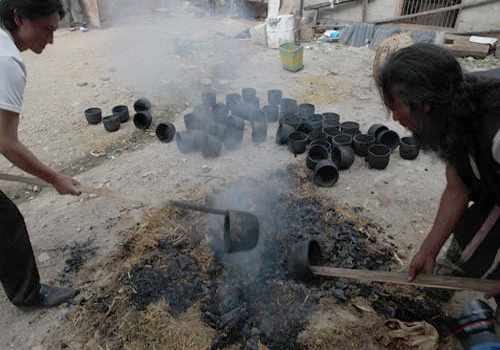A Bite of China – the Secret of Black Pottery in the Kitchen
2012-08-17China Food
It doesn’t seem possible to make an inarguable classification of cuisines simply in accordance with different regions, nor is it likely to count how many Chinese dishes we have. Sometimes, compared with food materials, things like cooking duration, cooking utensils and cutting skill are even more indispensable to a first-class dish. In the China’s kitchen, there are, indeed, too many secrets and black pottery is just one of them.

For many friends overseas, what they know is that Shangri-La is poetic and pure land, but rarely do they realize that there exists a Tibetan tribe called Nixi where people have been living on highland barley and black pottery for thousands of years. It is a sedate place of Shangri-La. In the house of many Tibetans pottery is dried in the shade and bacon, which Tibetans call pipa meat, is hung. While fresh food is invaluable, stuff like this is easy to preserve. Nixi people are busy fertilizing highland barley, helping each other so that the best chance of that will not be missed. In the living present, they are still keeping their habits inherited from their ancestors.
Black pottery is symbolic of ancient Chinese civilization. Relatively young, Nixi black pottery is believed to have a history of three-thousand years by comparison with that in Rizhao, Shandong. Whenever you are ambling around the tribe, a few steps will lead you to catching a glimpse of Nixi people making black pottery. Although they are sold to travellers from time to time, yet they are by no means the crafts but the secret in the kitchen of each household. While new cooking utensils have already set foot in Nixi people’s daily life, they continue using black pottery to cook rice, preparing food and making butter tea on a daily basis.

Climate of Nixi, if not the most, is agreeable, which is conductive to making the special red clay in Tangdui village of Nixi the only pug to make Nixi black pottery. And villagers have an easy access to this gift from our Mother Nature. In their heart, ambient mountains are always sacred and magic.
Craftsmen in Nixi are as adept at making black pottery as their forefathers were. Ricks should be heaped on the ground for the calcination of black pottery, and pine needles and saw dusts should be stack up in process. The finished product all over is black - a colour esteemed by the Tibetans; it is ultimately attributed to the chemical reaction between carbon molecules and pug.

In the modern kitchen today, ceramic cooking utensils are no longer conspicuous, but they must have been the leading role in all kitchens around China before the advent of bronze ware. And Nixi black pottery still acts as a living specimen and has witnessed a prodigious leap in cooking methods – boiling came into being. It is a method of cooking between roasting and baking that few people could imagine without the birth of black pottery. From then on, boiling and black pottery go hand in hand with one another closely. As the medium for water and fire, black pottery makes it possible heat transferred to food.
This is the secret in Nixi people’s kitchens. Thousands years have elapsed; secret is no more the secret but the common way of cooking in people’s daily life. So, the so-called secret in the kitchen is the art of water and fire on the surface; in effect, it is the harmonious relationships between human beings and other creatures. In short, the secret in the kitchen is no secret.
---Gaea(VisitOurChina)
Preview:A Bite of China- Power of time on sausage
Next:Dreamlike Bamboo Rafting on Li River Organized by Guilin Tianyuan Company




